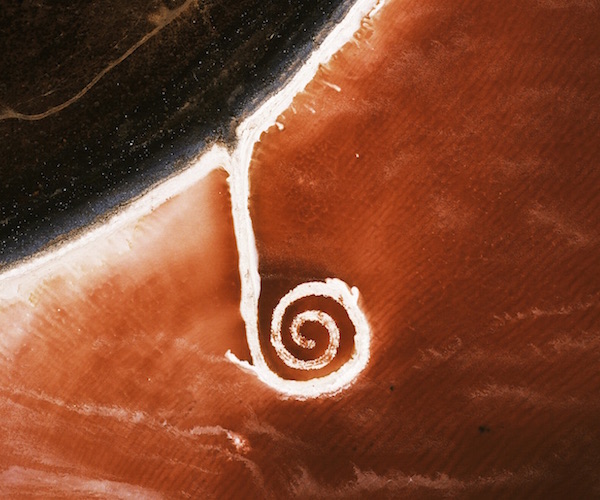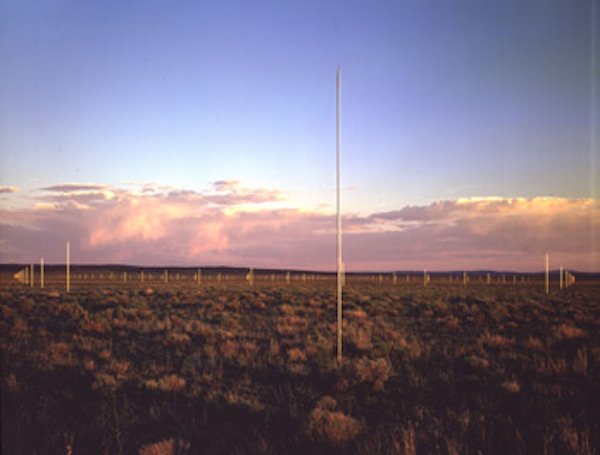Film Review: “Troublemakers” — Aesthetic Agitation on a Gargantuan Scale
Land art is an outgrowth of the rebellious ’60s; radicalism taking the form of ambitious topographical rearrangement.
Troublemakers: The Story of Land Art, directed by James Crump. At the Museum of Fine Arts, Boston, MA through January 21.

Robert Smithson’s iconic “Spiral Jetty, a 1,500 foot-long coil of basalt that juts out into the Great Salt Lake in Utah. One of the images in “Troublemakers: The Story of Land Art,” screening at the MFA Boston.
By Paul Dervis
This 2015 documentary is fascinating, though at times (consider the subject), a bit pretentious. In a nutshell, the narrative follows a group of counterculture artists — the anti-war, hippy variety of the late ’60s and early ’70s — who abandoned the New York art scene to create giant artworks on the vast desert canvases of the American southwest.
The focus is on three artists: Michael Heizer, Robert Smithson, and Walter De Maria, as well as their Patron Virginia Dwan, a New York gallery owner and heiress to the 3M Corporation.
The film inter-splices archival footage of the young bucks musing about their art with contemporary interviews with surviving members of the group. There is much (in truth, too much) airy philosophizing about the anti-intellectual energies that drive what they are up to. Thankfully, along the way we are treated to impressive images of their provocatively grandiose work — these visions range from the vibrantly colorful to the starkly black and white.
Heizer does most of his work in the Sierra Navadas. Here he has dug holes that, when viewed from the sky, form shapes that resemble gargantuan paintings. His sculptural projects are massive, epic challenges to the imagination. One piece, for example, is a 520 mile earthwork sculpture. It could hold multiple art galleries! An interesting aside about Heizer. He is the son of archeologist Robert Heizer. It isn’t surprising that the son of an archeologist, who had gone on digs with his father, would be drawn to this new form of art.
Robert Smithson, a New Jersey native, first became interested in what is called ‘land art’ in his native state. He searched for real estate that was large enough to contain his oversized work. He found places that would do the trick, but they were not available. The spaces that he could acquire simply didn’t suit his needs. While he was grappling with this problem he started to produce artwork that randomly combined rocks and dirt. He exhibited out West and stayed. His most famous art work, Spiral Jetty, was created in Utah, by the Great Salt Lake. Made of rock, dirt, and salt, the piece is a 1500 foot long spiral-shaped jetty that curls counterclockwise. One of the most interesting aspects of this giant earthwork sculpture is that it can only be seen in times of drought; otherwise it is submerged under water. Smithson made a 32-minute color film about Spiral Jetty.
Smithson died shortly after creating Spiral Jetty when his airplane crashed while he was searching for new territory to work in. His wife, artist (Worcester born, Tufts University educated) Nancy Holt continued working in land art herself, as well as in more conventional mediums.

Walter De Maria, “The Lightning Field,” 1977. Long-term installation, western
New Mexico. Photo: John Cliett.
De Maria saw land art as a means of dramatizing environmental changes; his works combine nature, weather, and light. His 1977 instillation The Lightning Field (in Western New Mexico) is made up of 400 stainless steel posts with solid, pointed tips, arranged in a rectangular 1 mile × 1 kilometre grid array. Weather conditions continually transform the optics of this ‘field.’ For example, during thunderstorms the posts light up; the visuals change with the light throughout the day.
This film provides an informative study in cultural continuity and juxtaposition: footage shot in the famed Max’s Kansas City in Manhattan (as well as other hip enclaves of the ’60s New York art scene) are set against views of the massive deserts of the Southwest. The result is an ironic history lesson about the forms that alternative art can take America. (Big Art for a Big Country.) Land art is an outgrowth of the rebellious ’60s; radicalism taking the form of ambitious topographical rearrangement. A radical sensibility — political protest, ecological concern, condemnation of urban sprawl — is expressed through the wholesale reshaping of the landscape.
And, one more thing about the group’s utopian dreams. In contrast to the conventional art world, the artists here support each other. They are only competing with themselves — they have rejected the competitive world of the big cities.
Paul Dervis has been teaching drama in Canada at Algonquin College as well as the theatre conservatory Ottawa School of Speech & Drama for the past 15 years. Previously he ran theatre companies in Boston, New York, and Montreal. He has directed over 150 stage productions, receiving two dozen awards for his work. Paul has also directed six films, the most recent being 2011’s The Righteous Tithe.
Tagged: James Crump, Michael Heizer, Paul Dervis, Robert Smithson, Troublemakers: The Story of Land Art, documentary, land art
